

Partner Elisabeth Marbury, Husband Charles Mendl
Queer Places:
Irving House, 122 E 17th St, New York, NY 10003, USA
13 Sutton Pl, New York, NY 10022
Père Lachaise Cemetery, 16 Rue du Repos, 75020 Paris, Francia
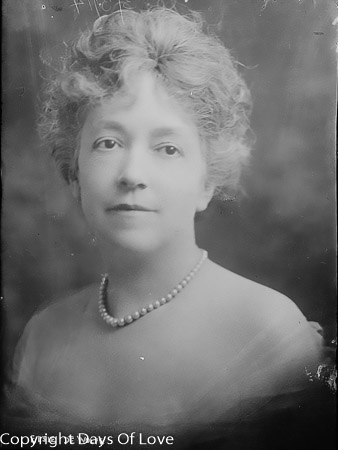 Elsie
de Wolfe, also known as Lady Mendl,[1]
(December 20, 1859?[2][3][4]
– July 12, 1950) was an American actress, interior decorator, nominal author
of the influential 1913 book The House in Good Taste,[5]
and a prominent figure in New York, Paris, and London society. She was the
longtime companion of
Elisabeth
Marbury. They met at a luncheon given by their mutual friend,
Sarah Cooper Hewitt (mother of the Hewitt Sisters,
Eleanor and Sarah Hewitt.)
Elsie
de Wolfe, also known as Lady Mendl,[1]
(December 20, 1859?[2][3][4]
– July 12, 1950) was an American actress, interior decorator, nominal author
of the influential 1913 book The House in Good Taste,[5]
and a prominent figure in New York, Paris, and London society. She was the
longtime companion of
Elisabeth
Marbury. They met at a luncheon given by their mutual friend,
Sarah Cooper Hewitt (mother of the Hewitt Sisters,
Eleanor and Sarah Hewitt.)
According to The New Yorker, "Interior design as a profession was invented by Elsie de Wolfe,"[6] although the praise is not strictly true. De Wolfe was certainly the most famous name in the field until the 1930s, but the profession of interior decorator/designer was recognized as a promising one as early as 1900,[7] five years before she received her first official commission, The Colony Club in New York. During her married life (from 1926 until her death in 1950) the press often referred to her as Lady Mendl. She was born in New York City and died at Versailles, France. Cremated, her ashes were placed in a common grave, the lease expired, in Pere Lachaise Cemetery in Paris.[8]
Among de Wolfe's distinguished clients were Anne Harriman Vanderbilt, Anne Morgan, the Duke and Duchess of Windsor, Elizabeth Milbank Anderson and Henry Clay and Adelaide Frick.[9] She transformed the interiors of wealthy homes from dark wood, heavily curtained palaces into light, intimate spaces featuring fresh colors and a reliance on 18th-century French furniture and accessories.[4][10][11][12][13]
In her autobiography, de Wolfe — born Ella Anderson de Wolfe and the only daughter of a Canadian-born doctor —called herself a "rebel in an ugly world." Her sensitivity to style and color was acute from childhood. Arriving home from school one day, she found her parents had redecorated the drawing-room:
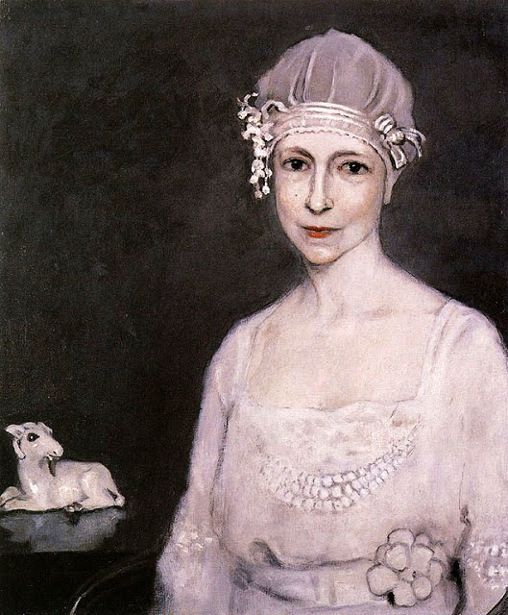
Elsie De Wolfe, by Romaine Brooks, 1914-1915
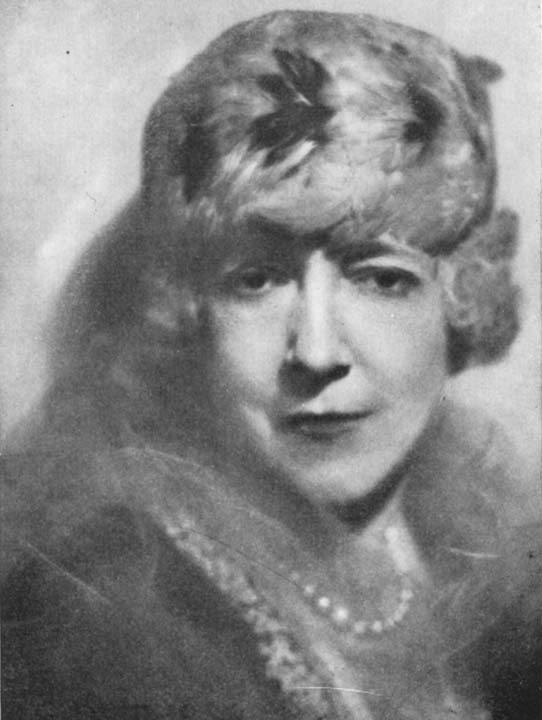
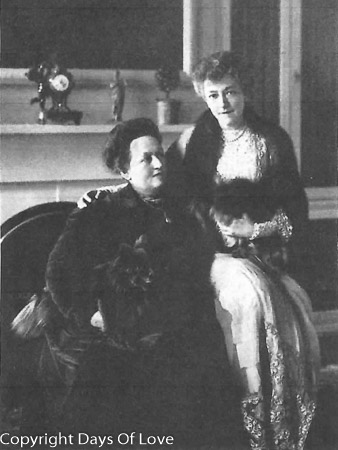
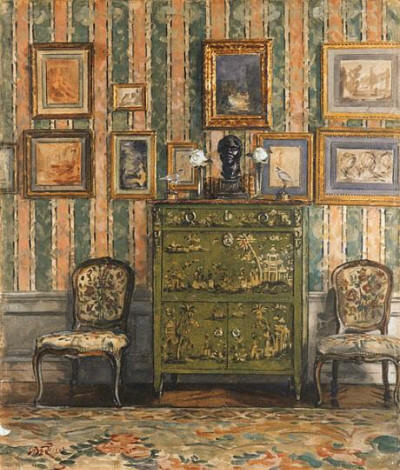
Elsie De Wolfe’s Green Lacquer Cabinet, The Villa Trianon, 1920-29,
First Colony Club, NYC
Irving House
Hutton Wilkinson, president of the Elsie de Wolfe Foundation, clarifies that many things de Wolfe hated, such as "pickle and plum Morris furniture," are prized today by museums and designers. “De Wolfe simply didn't like Victorian, the high style of her sad childhood," Wilkinson said, "and chose to banish it from her design vocabulary."[15]
De Wolfe's first career choice was that of actress. She originally appeared with The Amateur Comedy Club in New York City as Lady Clara Seymour in "A Cup of Tea," (April 1886), and as Maude Ashley in "Sunshine," a one act comedy by Fred W. Broughton (December 1886). Her success led to a full-time theatrical career, making her professional debut in Sardou's Thermidor in 1891, playing the rôle of Fabienne with Forbes-Robertson.[16] In 1894 she joined the Empire Stock Company under Charles Frohman. In 1901 she brought out The Way of the World under her own management at the Victoria Theatre, and later toured the United States in the role.[16] On stage, she was neither a total failure nor a great success; one critic called her “the leading exponent of the peculiar art of wearing good clothes well.”[17] She became interested in interior decorating as a result of staging plays, and in 1903 she left the theater to launch a career as a decorator.[18]
Undoubtedly one of the first interior designers, Elsie de Wolfe is considered by some to have invented the occupation, although evidence reveals the profession existed before she made her considerable name. Through her efforts, American homes were introduced to a succession of sophisticated yet simple ideas, generally based on Elsie's preference for late 18th century French style.
Many elements aided her in becoming such an influential figure in the emerging field - her social connections, her reputation as an actress and her success in decorating the interior of the house, Washington Irving House, she shared with her close friend, Elisabeth Marbury. It was during an amateur production for the opening of swank Tuxedo Park in 1886 that Marbury met de Wolfe.
Preferring a brighter scheme of decorating than was fashionable in Victorian times, she helped convert interiors of dark, heavy draperies and overly ornate furnishings into light, soft, more feminine rooms. She made a feature of mirrors, which both illuminated and expanded living spaces, brought back into fashion furniture painted white or pale colors, and indulged her taste for Chinoiserie, chintz, green and white stripes, wicker, trompe-l'oeil effects in wallpaper, and trellis work motifs, suggesting the allure of the garden. As de Wolfe claimed: “I opened the doors and windows of America, and let the air and sunshine in.” Her inspiration came from 18th century French and English art, literature, theater and fashion.[11]
De Wolfe's taste was also practical, eliminating in her schemes the clutter that occupied Victorian homes, enabling people to entertain more guests comfortably. She also popularized the chaises longue, faux-finish treatments, and animal print upholstery.
In 1886, the Hewitt sisters (Eleanor Hewitt and Sarah Hewitt) introduced Elizabeth Marbury to de Wolfe. The future interior decorator was then a was young amateur actress performing in a popular play called A Cup of Tea for the opening of the posh Tuxedo Club, near the Hewitt country home in Ringwood, New Jersey. Marbury recalled in My Crystal Ball: “It was soon after my visit to Tuxedo, and through my interest in the amateur stage, that I met Elsie de Wolfe. My friends, the Hewitts, asked us to luncheon. Caroline Duer, who had written some quite lovely sonnets, had given me copies of them. . . . I took Miss de Wolfe aside, showed her these verses and asked her to read them aloud, which she did, with a very pleasurable appreciation of their quality.”
In 1905, Stanford White, the architect for The Colony Club and a longtime friend, helped de Wolfe secure the commission for its interior design. The building, located at 120 Madison Avenue, (near 30th Street), would become the premier women's social club on its opening two years later, much of its appeal owing to the interiors de Wolfe arranged. Instead of the heavy, masculine overtones then pervasive in fashionable interiors, Elsie used light fabric for window coverings, painted walls pale colors, tiled the floors, and added wicker chairs and settees. The effect centered on the illusion of an outdoor garden pavilion.[19] (The building is now occupied by the American Academy of Dramatic Arts.)The success of the Colony Club proved a turning point in her own life and career, launching her fame as the most sought-after interior decorator of the day.[4][20]
Over the course of the next six years, Elsie designed interiors for many prestigious private homes, clubs and businesses on both the East and West coasts.
Lawrence Lebduska worked for Elsie de Wolfe, creating murals for a time. By 1936 he had received his first one man show, attracting the attention of Abby Aldrich Rockefeller, who was inspired by his work to open what became a famed museum of American folk art.
By 1913, Elsie de Wolfe's reputation had grown so that her studio took up an entire floor of offices on 5th Avenue. That year she received her greatest commission - from coal magnate Henry Clay Frick, one of the richest men in America at the time.
De Wolfe's 1926 marriage to diplomat Sir Charles Mendl, the British press attache in Paris[21],, was page one news in the New York Times. The marriage was platonic and one of convenience. The pair appeared to have married primarily for social amenities, entertaining together, but keeping separate residences. In 1935, when de Wolfe published her autobiography, she didn't mention her husband in it.[22] Although his career had been of no great distinction, Mendl's knighthood was allegedly bestowed due to his retrieval of letters from a gigolo who had been blackmailing Prince George, Duke of Kent.[23]
The Times reported "the intended marriage comes as a great surprise to her friends," a veiled reference to the fact that since 1892 de Wolfe had been living openly in what many observers accepted as a lesbian relationship. As the paper put it: "When in New York she makes her home with Miss Elizabeth Marbury at 13 Sutton Place." Sutton Place was nicknamed the Amazon Enclave due to the fact that also Anne Morgan and Anne Harriman Vanderbilt lived there.
The daughter of a prosperous New York lawyer, Elisabeth (Bessy) Marbury, like de Wolfe, was also a pioneer career woman. She was one of the first female theater agents and one of the first woman Broadway producers. Her clients included Oscar Wilde and George Bernard Shaw. During their nearly 40 years together, Marbury was initially the main support of the couple. Dave Von Drehle speaks of "the willowy De Wolfe and the masculine Marbury... cutting a wide path through Manhattan society. Gossips called them "the Bachelors."[18][24][25][26][27] Expecting nothing to change in their relationship due to her marriage to Mendl, de Wolfe remained Marbury's lover until the latter's death in 1933.[28]
In 1926 the New York Times described de Wolfe as "one of the most widely known women in New York social life," and in 1935 as "prominent in Paris society."
Her morning exercises were famous. In her memoir, de Wolfe wrote that her daily regimen at age 70 included yoga, standing on her head, and walking on her hands. "I have a regular exercise routine founded on the Yogi method," Elsie said, "introduced to me by Anne Vanderbilt and her daughter, Princess Murat. I stand on my head (and) I can turn cart wheels. Or I walk upside-down on my hands." [29]
In 1935, Paris experts named her the best-dressed woman in the world, noting that she wore what suited her best, regardless of fashion.[30]
De Wolfe had embroidered taffeta pillows bearing the motto "Never complain, never explain."[31] On first seeing the Parthenon, De Wolfe exclaimed "It's beige—my color!"[4][32][33]
At her house in France, the Villa Trianon, she had a dog cemetery in which each tombstone read, "The one I loved the best."[34]
My published books: